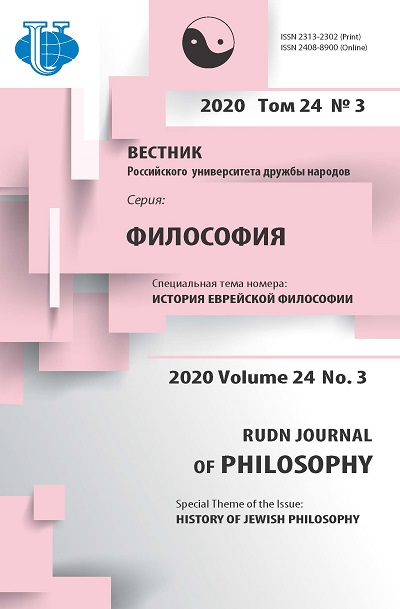Synthesis of Cultures of the East and West in the Philosophy of B.D. Dandaron
- Authors: Ulanov M.S.1
-
Affiliations:
- Kalmyk State University named after B. B. Gorodovikov
- Issue: Vol 24, No 3 (2020): HISTORY OF JEWISH PHILOSOPHY
- Pages: 502-511
- Section: PHILOSOPHY OF DIALOGUE
- URL: https://journals.rudn.ru/philosophy/article/view/24361
- DOI: https://doi.org/10.22363/2313-2302-2020-24-3-502-511
- ID: 24361
Cite item
Full Text
Abstract
The article deals with the phenomenon of synthesis of East and West cultures in the religious philosophy of B.D. Dandaron - one of the most famous representatives of Russian Buddhism in the XX century. The beginning of the spread of Buddhist teachings in Russian society is also connected with his extraordinary personality. Dandaron was engaged in active yoga, tantric practice, and also gave instructions to those who were interested in Buddhism. As a result, a small circle of people began to form around him who tried to study and practice Buddhism. Dandaron was also engaged in Buddhist activities, studied Tibetan history and historiography, and described the Tibetan collection of manuscripts. It is indicated that Dandaron not only made an attempt to consider Buddhism from the perspective of Western philosophy, but also created his own teaching, which was called “neobuddism”. As a result, he was able to conduct a creative synthesis of Buddhist philosophy with the Western philosophical tradition. In fact, he developed a philosophical system that claims to be universal and synthesized Buddhist and Western spiritual achievements. Trying to synthesize the Eastern and Western traditions of philosophical thought, Dandaron turned to the well-known comparative works of the Indian thinker S. Radhakrishnan and the Russian buddhologist F.I. Shcherbatsky. The author also notes the influence on the philosophy of neobuddism of the ideas of V.E. Sesemann, a neo-Kantian philosopher with whom Dandaron was personally acquainted. The idea of non-Buddhism had not only a philosophical and theoretical, but also a practical aspect, since the consideration of Buddhism from the perspective of Western philosophy helped to attract people of Western culture to this religion. In General, Dandaron’s desire to create a universal synthetic philosophical system was in line with the philosophical and spiritual search of Russian philosophy, and was partly related to the traditional problem of “East-West”, which has always been relevant for Russia.
Keywords
About the authors
Mergen Sanjievich Ulanov
Kalmyk State University named after B. B. Gorodovikov
Author for correspondence.
Email: ulanov1974@mail.ru
Doctor of Philosophy, Professor of the Department of Philosophy and Culturology
11 Pushkin str., Republic of Kalmykia, Elista, Russian Federation, 358000References
- Belka L. Mandala Dandarona: vizual'naya reprezentaciya istorii buddijskoj obshchiny sovetskogo perioda. Tartaria Magna. 2012; (1): 148—168. (In Russian).
- Morozova MB. Tragediya Bidii Dandarona kak otrazhenie sud'by buddizma v Rossii posle nacional'noj katastrofy 1917 goda. Svet Hristov prosveshchaet vsekh: Al'manah Svyato-Filaretovskogo pravoslavno-hristianskogo instituta. 2016; (18): 98—113. (In Russian).
- Lepekhov SYu. Vydayushchijsya buddolog i buddijskij religioznyj deyatel' (k 100-letiyu B.D. Dandarona). Vestnik Buryatskogo nauchnogo centra Sibirskogo otdeleniya Rossijskoj akademii nauk. 2014; (4): 318—327. (In Russian).
- Novaya filosofskaya enciklopediya. V chetyrekh tomah. Moscow: Mysl'; 2010. Vol. III. P.511. (In Russian).
- Jonkus D. Rukopisi Vasiliya Sezemana v Vil'nyuse i v Ulan-Ude. Predislovie k publikacii rukopisej Vasiliya Sezemana — Sheler, Losskij, Bergson (1950—1955 gg.). HORIZON. Fenomenologicheskie issledovaniya. 2017(1): 201—210. (In Russian).
- Ulanov MS. Buddijskaya tradiciya v SSSR vo vtoroj polovine HKH veka (social'no-filosofskij analiz). Vestnik Kalmyckogo gosudarstvennogo universiteta. 2012; (2): 107—112. (In Russian).
- Dandaron BD. Pis'ma o buddijskoj etike. Saint Petersburg: Aletejya; 1997. 350 p. (In Russian).
- Dandaron BD. Mysli buddista. «CHernaya tetrad'». Saint Petersburg: Aletejya; 1997. 244 p. (In Russian).
- Bazarov AA, Cyrempilov NV. Tibetologiya sovetskogo perioda v Buryatii. Ocherk vtoroj. Vestnik Buryatskogo nauchnogo centra Sibirskogo otdeleniya Rossijskoj akademii nauk. 2012; (3): 228—242. (In Russian).
- Sumba-Hambo. Istoriya Kukunora, nazyvaemaya «Prekrasnye noty iz pesni Brahmy». Moscow: Nauka; 1972. 166 p. (In Russian).
- Istochnik mudrecov: Tibetsko-mongol. terminol. slovar' buddizma. Ulan-Ude: Buryat. kn. izd-vo, 1968. Vol. 1, 1968. 166 p. (In Russian).
- Garmaev DO. Filosofskie osnovy neobuddizma B.D. Dandarona: diss. abstract. Moscow; 2005. 24 p. (In Russian).
- Al'bedil' MF. O neobuddizme B.D. Dandarona. Uchenie Buddy v Rossii 250 let institutu Pandito Hambo-lam. Saint Petersburg: Institut vostochnyh rukopisej RAN; 2015. P.145—154. (In Russian).
- Nacog-Randol. Karnatantra, opora velikogo ucheniya, nazyvaemaya «Zercalo mekhanizma glubokogo soderzhaniya». URL: http://www.dandaron.ru/rus/theory/ karnatantra.html (In Russian).
- Lepekhov SYu. B.D. Dandaron — buddolog, tibetolog, filosof. Vestnik Buryatskogo nauchnogo centra Sibirskogo otdeleniya Rossijskoj akademii nauk. 2012 (3): 259—266. (In Russian).
Supplementary files















